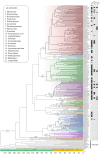The interactions of ants with their biotic environment
- PMID: 28298352
- PMCID: PMC5360932
- DOI: 10.1098/rspb.2017.0013
The interactions of ants with their biotic environment
Abstract
This special feature results from the symposium 'Ants 2016: ant interactions with their biotic environments' held in Munich in May 2016 and deals with the interactions between ants and other insects, plants, microbes and fungi, studied at micro- and macroevolutionary levels with a wide range of approaches, from field ecology to next-generation sequencing, chemical ecology and molecular genetics. In this paper, we review key aspects of these biotic interactions to provide background information for the papers of this special feature After listing the major types of biotic interactions that ants engage in, we present a brief overview of ant/ant communication, ant/plant interactions, ant/fungus symbioses, and recent insights about ants and their endosymbionts. Using a large molecular clock-dated Formicidae phylogeny, we map the evolutionary origins of different ant clades' interactions with plants, fungi and hemiptera. Ants' biotic interactions provide ideal systems to address fundamental ecological and evolutionary questions about mutualism, coevolution, adaptation and animal communication.
Keywords: ants; bacteria; fungi; insects; interactions; plants.
© 2017 The Author(s).
Figures


References
-
- Bolton B.2012. AntCat. An online catalog of the ants of the world. See http://www.antcat.org .
-
- Hölldobler B, Wilson EO. 1990. The ants. Cambridge, MA: Harvard University Press.
Publication types
MeSH terms
LinkOut - more resources
Full Text Sources
Other Literature Sources
Medical
